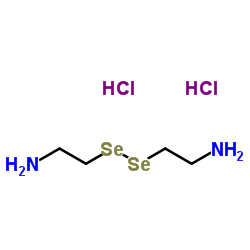Studies on the reducing systems for plant and animal thioredoxin-independent methionine sulfoxide reductases B.
Di Ding, Daphna Sagher, Edith Laugier, Pascal Rey, Herbert Weissbach, Xing-Hai Zhang
文献索引:Biochem. Biophys. Res. Commun. 361(3) , 629-33, (2007)
全文:HTML全文
摘要
Two distinct stereospecific methionine sulfoxide reductases (Msr), MsrA and MsrB reduce the oxidized methionine (Met), methionine sulfoxide [Met(O)], back to Met. In this report, we examined the reducing systems required for the activities of two chloroplastic MsrB enzymes (NtMsrB1 and NtMsrB2) from tobacco (Nicotiana tabacum). We found that NtMrsB1, but not NtMsrB2, could use dithiothreitol as an efficient hydrogen donor. In contrast Escherichia coli thioredoxin (Trx) could serve as a reducing agent for NtMsrB2, but not for NtMsrB1. Similar to previously reported human Trx-independent hMsrB2 and hMsrB3, NtMsrB1 could also use bovine liver thionein and selenocysteamine as reducing agents. Furthermore, the unique plant Trx-like protein CDSP32 was shown to reduce NtMsrB1, hMsrB2 and hMsrB3. All these tested Trx-independent MsrB enzymes lack an additional cysteine (resolving cysteine) that is capable of forming a disulfide bond on the enzyme during the catalytic reaction. Our results indicate that plant and animal MsrB enzymes lacking a resolving cysteine likely share a similar reaction mechanism.
相关化合物
| 结构式 | 名称/CAS号 | 分子式 | 全部文献 |
|---|---|---|---|
 |
硒代胱胺盐酸盐
CAS:3542-13-0 |
C4H14Cl2N2Se2 |
|
Pulse radiolysis studies on reactions of hydroxyl radicals w...
2008-04-10 [J. Phys. Chem. B 112(14) , 4441-6, (2008)] |
|
Oxidation of glutathione and superoxide generation by inorga...
2008-09-01 [Biofactors 31(1) , 55-66, (2007)] |
|
Separation of organoselenium compounds and their electrochem...
2004-07-01 [Anal. Bioanal. Chem 379(5-6) , 770-6, (2004)] |
|
Selenium functionalized intraocular lenses inhibit posterior...
2009-11-01 [Exp. Eye Res. 89(5) , 728-34, (2009)] |
|
Cytolysis of human erythrocytes by a covalent antibody-selen...
1995-12-01 [Free Radic. Biol. Med. 19(6) , 713-24, (1995)] |